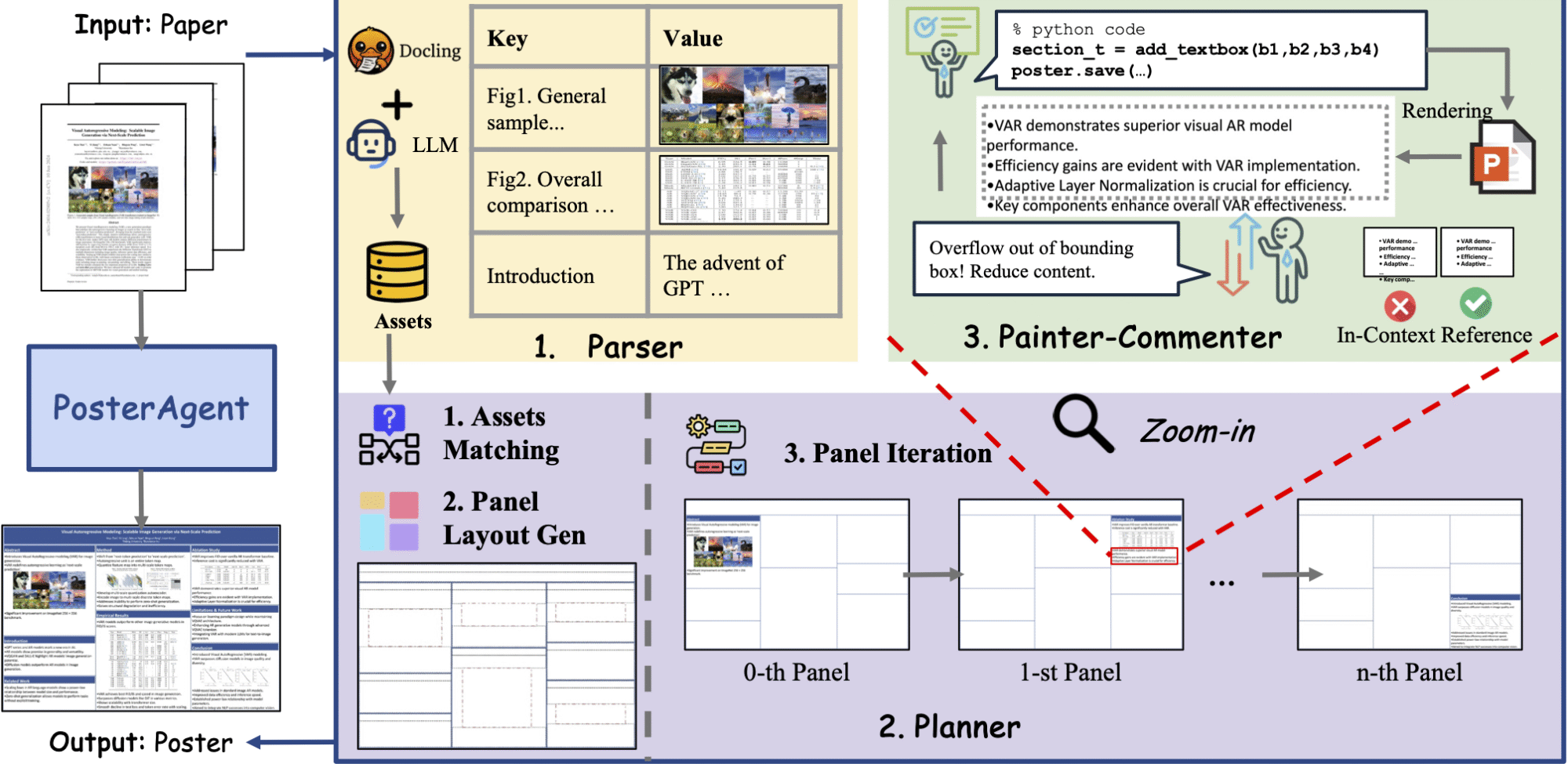
🎓 Paper2Poster: Transforming Research Papers into Visual Masterpieces with AI

🧭 Introduction
Every researcher has been there: a conference deadline looms, your paper is accepted, and now it’s time to create a poster that summarizes months (or years) of work in a clean, digestible, and engaging visual format. But poster design isn’t always intuitive—and for many, it becomes a dreaded bottleneck in the research pipeline.
Paper2Poster offers a game-changing solution. Developed by a team of researchers across the University of Waterloo, National University of Singapore, and the University of Oxford, this tool automatically transforms academic papers into professionally formatted scientific posters using AI.
At the core is PosterAgent, a smart, multi-agent system that can read, plan, and render posters—just like a human designer might, but faster and at scale. The aim? To simplify and democratize poster creation so researchers can focus on their science.
🔍 The Problem: Poster Design Is Broken
Despite their ubiquity at conferences, scientific posters haven’t changed much in decades. The process is often manual and labor-intensive, involving:
- Condensing complex research into short summaries
- Selecting and editing figures, tables, and graphs
- Designing a visually appealing, readable layout
- Managing formatting tools like PowerPoint, Illustrator, or LaTeX
Even experienced researchers can spend 10–15 hours designing a poster—and that’s if they’re already familiar with design tools. For early-career academics or non-native English speakers, the task becomes even more daunting.
This inefficiency not only wastes time but also creates inconsistency in how research is presented. A poorly designed poster can hide good science, while a well-designed one can highlight weak work. Clearly, we need tools that level the playing field.
Paper2Poster changes that.
Developed by a team of researchers from the University of Waterloo, National University of Singapore, and University of Oxford, this AI-powered tool automates the entire process of poster creation. With its intelligent system, called PosterAgent, Paper2Poster analyzes a scientific paper and generates a well-organized, visually appealing poster—ready for presentation.
Behind the project are researchers Wei Pang, Kevin Qinghong Lin, Xiangru Jian, Xi He, and Philip Torr, who recognized a clear need for better tools in scientific communication. By combining natural language processing, layout planning, and AI-assisted design, they’ve created a system that’s not just functional—it’s transformative.
Whether you’re preparing for your next conference or looking to make your research more accessible, Paper2Poster offers a glimpse into the future of academic presentation.
🎓 Paper2Poster: Transforming Research Papers into Visual Masterpieces with AI
In the evolving landscape of scientific communication, effectively conveying research findings is paramount. Traditional methods often rely on static posters and lengthy papers, which may not fully encapsulate the essence of a study. Recognizing this challenge, the Paper2Poster project introduces an innovative approach to automate the creation of scientific posters directly from research papers.
At the heart of this endeavor is PosterAgent, a sophisticated multi-agent system designed to convert academic papers into visually coherent and informative posters. This system employs a top-down, visual-in-the-loop pipeline comprising three primary components:
- Parser: Distills the paper into a structured asset library, extracting key elements such as titles, abstracts, figures, and tables.
- Planner: Aligns text-visual pairs into a binary-tree layout that preserves reading order and spatial balance, ensuring a logical flow of information.
- Painter-Commenter Loop: Refines each panel by executing rendering code and utilizing Visual Language Models (VLMs) to eliminate overflow and ensure alignment, enhancing the visual appeal and clarity of the poster.
This automated process not only streamlines the creation of scientific posters but also ensures that the final output is both aesthetically pleasing and rich in content.
The Paper2Poster project is the brainchild of a collaborative team of researchers from esteemed institutions:
- Wei Pang: University of Waterloo
- Kevin Qinghong Lin: National University of Singapore
- Xiangru Jian: University of Waterloo
- Xi He: National University of Singapore
- Philip Torr: University of Oxford
Their collective expertise has culminated in a project that not only addresses the challenges of scientific poster creation but also sets a new standard for automation in academic dissemination.
For those interested in exploring this innovative tool, the Paper2Poster system is fully open-source and available on GitHub. This initiative marks a significant step towards enhancing the accessibility and impact of scientific research through automated visual communication.
🔍 The Problem: Scientific Posters Are Time-Consuming to Create
Creating a scientific poster isn’t just about copying and pasting content—it’s about distilling the core message of a paper, designing an intuitive layout, and making it visually appealing. For most researchers, especially those without a design background, this can be a frustrating and inefficient process.
Posters also need to meet specific conference dimensions, use limited space effectively, and highlight the most relevant visuals and data. Balancing these constraints with clear communication is a real challenge.
🤖 The Solution: Introducing Paper2Poster
Paper2Poster automates poster creation using AI and a multi-agent system called PosterAgent. The tool breaks down a research paper into its essential components, plans a layout based on logical flow, and renders a full poster with minimal user input.
At a high level, it follows a three-stage process:
- Parsing: Extracts key elements like the title, abstract, figures, and tables.
- Planning: Organizes these elements into a logical, readable layout using binary-tree principles.
- Rendering: Uses a visual language model to refine the layout, eliminate clutter, and enhance readability.
🧠 H🧠 Under the Hood: How Paper2Poster Works
At the heart of Paper2Poster is PosterAgent, a multi-agent framework that works in three major stages:
1. 🧾 Parser Agent: Understanding the Paper
This agent reads the scientific paper (usually in LaTeX or PDF format) and extracts all the core content:
- Title, authors, and abstract
- Section headers and main text
- Figures, tables, and captions
- Equations and references
It then organizes these into a structured “asset library” that forms the foundation for layout decisions.
2. 🧩 Planner Agent: Structuring the Layout
Using a binary-tree layout model, the planner arranges content blocks in a way that reflects natural reading order and visual hierarchy. Key considerations include:
- Logical grouping of text and visuals
- Maintaining consistent panel sizes
- Maximizing space without overwhelming the viewer
This planning is guided by a top-down approach that mimics how a designer might sketch a draft layout before fine-tuning it.
3. 🖼️ Painter-Commenter Loop: Refinement and Aesthetics
Here’s where the magic happens.
The “painter” module renders the layout into code (using LaTeX or HTML/CSS), while the “commenter” evaluates the output using a Visual Language Model (VLM). It provides feedback on layout issues such as:
- Overflowing text
- Misaligned elements
- Imbalanced whitespace
- Missing visual connections
This loop continues iteratively until the final poster is both readable and visually polished.
📈 What Makes Paper2Poster Unique?
While there are other poster-generating tools out there, Paper2Poster stands out in several ways:
- Fully Automated: No templates, no drag-and-drop—just upload your paper and get a poster.
- Multimodal Understanding: Integrates both text and visual elements for a holistic layout.
- Visual Feedback Loop: Uses AI to refine design based on how a human might perceive it.
- Open Source: Available on GitHub for community use and development.
It’s not just a tool—it’s a research contribution toward better multimodal document understanding.
🌐 Explore the Tool
Curious to try it? You can test Paper2Poster or explore the source code:
The system supports LaTeX-formatted papers and has a command-line interface that allows users to customize the rendering process or integrate it into their research workflows.
✨ The Bigger Picture
Paper2Poster reflects a broader trend in AI: automating not just content generation, but visual and spatial communication. This project shows how intelligent agents can assist researchers with time-consuming but essential academic tasks, freeing them up to focus on the science itself.
And it’s only the beginning.
In the future, we might see end-to-end tools that:
- Generate slides for oral presentations
- Build graphical abstracts automatically
- Create dynamic, interactive posters for virtual conferences
- Assist with summarizing research for broader audiences
By lowering the barrier to effective communication, tools like Paper2Poster empower researchers everywhere to share their work more effectively, clearly, and beautifully.
🧪 Final Thoughts
Poster creation might seem like a small detail in the grand scheme of academic research, but in reality, it plays a critical role in how scientific work is perceived, shared, and remembered—especially at conferences, workshops, and symposiums. A poster is often a researcher’s first line of engagement with their peers. It needs to capture attention quickly, convey complex ideas clearly, and invite meaningful discussion.
Yet despite its importance, the design and production of a scientific poster are frequently overlooked or rushed due to time constraints, lack of design expertise, or simply because it’s viewed as a chore. The result? Posters that are overcrowded, difficult to read, or fail to communicate the core message of the research.
Paper2Poster reimagines this part of the academic workflow. By automating the transformation of research papers into clean, structured, and visually coherent posters, it frees researchers from the burden of manual formatting and design. More importantly, it ensures that the scientific story being told is communicated with clarity and impact.
This is more than just a convenience—it’s a meaningful advancement in how we think about multimodal communication in science. With tools like PosterAgent, we’re beginning to bridge the gap between knowledge creation and knowledge presentation. We’re not only saving time; we’re raising the standard for how research is shared with the world.
As AI continues to enhance productivity in research—through literature reviews, code generation, data visualization, and now poster design—it’s becoming increasingly clear that the future of academia includes intelligent tools that work alongside researchers to amplify their voice and their vision.
With Paper2Poster, the first impression your research makes can now be effortless, elegant, and intelligently designed.
📘 Core Paper
- Paper2Poster: Towards Multimodal Poster Automation from Scientific Papers
This is the foundational research paper introducing the Paper2Poster project. It discusses the challenges of academic poster generation, presents a new benchmark and evaluation metrics, and introduces PosterAgent, the multi-agent system for automating poster creation.
🔗 Read the paper on arXivarXiv
🧰 Open-Source Code
- GitHub Repository: Paper2Poster
The official open-source implementation of the Paper2Poster system, including the PosterAgent pipeline and supporting datasets.
🔗 Explore the GitHub repository
🧪 Related Research
- P2P: Automated Paper-to-Poster Generation and Fine-Grained Benchmark
This paper presents a flexible, LLM-based multi-agent framework for generating high-quality academic posters directly from research papers, along with a new instruction dataset and evaluation benchmark.
🔗 Read on arXivarXiv - PosterBot: A System for Generating Posters of Scientific Papers with Neural Models
Introduces PosterBot, an automatic poster generation system that selects important sections from a scholarly paper and generates corresponding panels to create a complete poster.
🔗 Read the paperAAAI Open Access Journal+1AAAI+1 - SciPostLayout: A Dataset for Layout Analysis and Layout Generation of Scientific Posters
Presents a dataset consisting of scientific posters and manual layout annotations for layout analysis and generation, aimed at reducing the workload of authors and helping readers understand the outline of the paper visually.
🔗 Read on arXivarXiv

